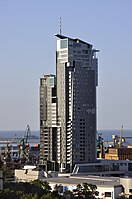Gotenhafen
| Gdynia | |||||||
|---|---|---|---|---|---|---|---|
Dar Pomorza sailing ship • Pier in Orłowo • Baltic Sea |
|||||||
|
|||||||
| Motto: Uśmiechnij się, jesteś w Gdyni (Smile, you're in Gdynia) |
|||||||
| Coordinates: 54°30′N 18°32′E / 54.500°N 18.533°E | |||||||
| Country | Poland | ||||||
| Voivodeship | Pomeranian | ||||||
| County | city county | ||||||
| City rights | February 10, 1926 | ||||||
| Boroughs | 22 districts | ||||||
| Government | |||||||
| • Mayor | Wojciech Szczurek | ||||||
| • Vice President | Ewa Łowkiel | ||||||
| • Vice President | Michał Guć | ||||||
| • Vice President | Bogusław Stasiak | ||||||
| • Vice President | Marek Stępa | ||||||
| Area | |||||||
| • Total | 135 km2 (52 sq mi) | ||||||
| Highest elevation | 205 m (673 ft) | ||||||
| Lowest elevation | 0 m (0 ft) | ||||||
| Population (31.03.2014) | |||||||
| • Total | 247,799 | ||||||
| • Density | 1,800/km2 (4,800/sq mi) | ||||||
| Time zone | CET (UTC+1) | ||||||
| • Summer (DST) | CEST (UTC+2) | ||||||
| Postal code | 81-004 to 81-919 | ||||||
| Area code(s) | +48 58 | ||||||
| Car plates | GA | ||||||
| Website | http://www.gdynia.pl | ||||||
Gdynia [ˈɡdɨɲa] (German: Gdingen, Kashubian: Gdiniô) is a city in the Pomeranian Voivodeship of Poland and an important seaport of Gdańsk Bay on the south coast of the Baltic Sea. Located in Kashubia in Eastern Pomerania, Gdynia is part of a conurbation with the spa town of Sopot, the city of Gdańsk and suburban communities, which together form a metropolitan area called the Tricity (Trójmiasto), with a population of over a million people.
For centuries, Gdynia remained a small agricultural and fishing village on the Baltic coast. At the beginning of the 20th-century Gdynia became as a seaside resort town and experienced an inflow of tourists. This also triggered an increase in local population. After Poland regained its independence in 1918, a decision was made to construct a Polish seaport in Gdynia, between the Free City of Danzig (a semi-autonomous city-state under joint League of Nations and Polish administration) and German Pomerania, making Gdynia the primary economic hub of the Polish Corridor. It was then that the town was given a more cosmopolitan character with modernism being the dominant architectural style and emerged as a city in 1926.
The rapid development of Gdynia was interrupted by the outbreak of World War II. Although the German troops refrained from deliberate bombing, the newly built port and shipyard were completely destroyed. The population of the city suffered much heavier losses as most of the inhabitants were evicted and expelled. The locals were either displaced to other regions of occupied Poland or sent to Nazi concentration camps throughout Europe. After the war, Gdynia was settled with the former inhabitants of Warsaw and lost cities such as Lviv and Vilnius in the Eastern Borderlands. The city was gradually regenerating itself with its shipyard being rebuilt and expanded. In December 1970 the shipyard workers protest against the increase of prices was bloodily repressed. This greatly contributed to the rise of the Solidarity movement in Gdańsk.
...
Wikipedia








